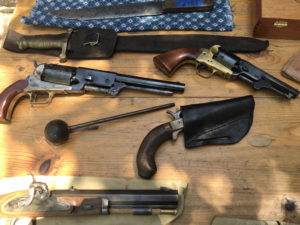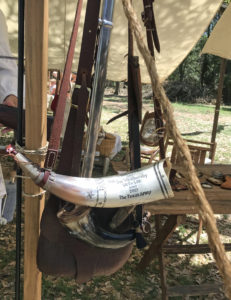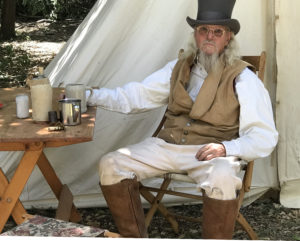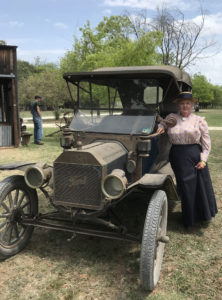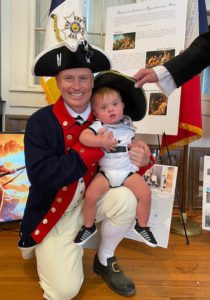(So, I know the suggestion started as a joke on my part – about the only hope for the Lone Ranger being a complete and total reboot, defaulting back to a more or less historically correct version, set in pre-Civil War Texas… but when Blondie suggested that I make it also a sort of YA chronicle and aimed for boys … well, I liked the idea. So without further ado – the set-up chapter. I don’t have a title yet, so any suggestions are welcome.)
Chapter 1
A dark winged shadow sailed on motionless wings. Jim Reade lay on his back in the desert dust, incuriously watching that ominous shadow circle, lower and lower until every finger-like dark feather became distinct against the burning sky, aware in a tiny corner of his mind that he should do something, should move. But he hurt in every bone, from his head down to his fingertips, and all the way to his booted toes. There was something flint-hard under his shoulder, unyielding, the sun had blazed on his exposed face and hands for many hours, and there was a slow crawl of blood oozing from his forehead, running back into his sweat-matted hair. It took a great deal of concentration and will to move his right hand, dropping the object clenched in it with a brief metallic clatter. The dark-winged shadow veered abruptly away. That sight recalled him to a sense of danger. Turkey vulture. Dropping down on something freshly – or not so freshly dead. What had happened? Jim willed his eyes and his memory to focus.
There … within sight and reach – a dapple-grey form which loomed as tall as a cliff not a hand-reach beyond, as still as death, it’s neck and head laid out at an unnatural angle, nostrils already being crawled over by a trail of industrious ants; Jim felt a twinge of regret and remorse – his horse, that he had paid twenty American dollars and the task of writing out a proper deed of sale for fifteen acres of land on Salado Creek for to the man who sold him the horse. Well, that was a waste of a good horse and a small part of his time … but Daniel had insisted. If he was to ride with Daniel’s Ranger company, he had to have a good horse, a good Sharps and a pair of good Colts. That tall and tow-headed sergeant of rangers – Captain Jack Hay’s right-hand man – had looked over Jim’s equipment and horse presented for inspection and nodded a silent assent. Daniel had clapped him on the shoulder and said, ‘Thanks, Dutch. Now, let’s ride, little brother!’
But I’m a lawyer, Jim had said to Daniel, when they met at Daniel’s little house in Bastrop, after Jim came hastening all the way from Galveston in answer to Daniel’s message. The Mexes have taken Bexar, Daniel had said in his message. They took every white man prisoner there, including Daddy – and dragged them back to Mexico in chains. Captain Hays, he’s already gone to follow them, with every man he could muster.
So is Daddy a lawyer, Daniel answered, white with suppressed fury. And those bastards took him with all the others there for the district court. The judge, the recorder, the district attorney – all the defense attorneys, the clerk and every one of those who had suits to be judged or came as witnesses. They brought their whole damned army to invade … again – and took them prisoner just for doing their civil duty. You’re a lawyer, little brother – but what happens when the law don’t do you no good at all? You put down your law books and you pick up a Colt. Else the law don’t mean anything at all. Join my company, pick up your trash – that which you can hitch to your saddle, and let’s you and I go rescue Daddy.
And that’s what Jim had done. Packed all four duodecimo volumes of Blackstone’s Commentaries in his saddle-bags, bought a pair of patent Colt revolving pistols – and the horse to carry them, since they made a not-inconsiderable burden, taken together with his Sharps rifle, the necessary tools and bullet-mold and metal powder-flask, and swore into Daniel’s company of ragged and ill-dressed Rangers … they did it in the plaza in front of the crumbling old chapel and the ruined presidio which surrounded it on the outskirts of the old town of Bexar. It didn’t look like the brief occupation of General Woll’s Mexican army had done any good to the old place. But they hadn’t done much harm, either. Colonel Caldwell and Captain Hays had lured the invaders away to the banks of the Salado, a piece a good bit north of town. And there had been a battle, and General Woll had gathered up his troops and skedaddled … stealthily, of course. For the Texas militia and mounted Ranger companies were assembling…
Jim Reade gathered up his scattered thoughts again. What had happened to him? Where was Daniel, and the other four Rangers who had gone out on long scout at Cap’n Hay’s orders? He couldn’t remember, which worried him. It cost him some pain to turn his head – the blue sky, the turkey-vulture floating lazily in it, the dappled body of his dead horse – all swam together. He pressed his eyelids tight together, waiting until the pounding of his heart stopped sending scorching patterns of light against them. Now Jim squinted against the blinding sun, falling almost parallel across the rolling desert scrubland and flat-topped hills along the Nueces. There were shadows, stretching out … and the tumbled still forms of men, laying in the unnatural positions in which sudden death had found them. They sprawled like rag dolls, and horribly splotched with blood already gone the color of dark red morocco leather, at throat, back or breast. The nearest to him wore a dark blue hunting coat, just like his brother – his hair the same light brown, and that was Daniel’s plain straw planter’s hat, hanging from a branch of mesquite shrub, tossing in the light breeze.
“Dan! Dan’l … Cap’n Reade!†Jim croaked. He attempted to rise, by rolling onto one side and levering his elbow against the ground, but unbearable, searing pain exploded in his shoulder and the black darkness descended again. After a time, that darkness receded. Jim blinked, hardly believing what he saw. The shadowy form of a man loomed over him, a young and weather-burnt face with a quizzical expression on it. Dark Indian braids hung over the young man’s naked shoulders, and three lines in red ocher painted across his cheeks. Comanche – he was done for, surely, Jim decided in despair. The shape he was in, he wouldn’t last long, under whatever torture the Comanche had in mind – and with any luck at all he should be unconscious almost at once. The other Rangers – and every settler in Texas, Anglo and Mexican alike – they all had stories of the sickening tortures which the Comanche inflicted on their live captives.
“Sorry … to deprive …you of … your fun,†Jim whispered, with the last of his wavering strength, and he almost thought he heard a reply in perfect English. “Wait until I set your arm, Ranger. That is all the amusement that I will need…â€
The next time Jim swam up to the surface of life, he was in a place that was dark, but dimly lit with moving shadows – a fire, a little distance from him. The sharp object under his shoulder was gone. It seemed that he lay on something relatively soft, inside the shelter of a shallow cave. He still hurt all over, but the pain was a lesser thing now, in his shoulder and arm, and in his head, which ached fiercely when he turned it to look in the direction of the fire. There was someone sitting beyond it, in the mouth of the small cave, silhouetted against a darkly-starry sky above, and a thicket of those spiny, thick-leaved cactus plants – the ripe red fruit and tender young leaves of which the Mexicans in Bexar relished very much. Jim struggled to focus his eyes and attention. He must have made some involuntary movement or a noise, for that someone stood, swift and almost noiseless, and padded around the fire with a plain tin cup in hand – the young Indian.
“You are aware,†he remarked, in good humor. “Good. This is sage and willow-bark tea. Very healing properties.†The young Indian knelt next to the rough pallet of blankets on which Jim lay, raised his head and held the cup to his lips so that he might drink easily.
“Who are you?†Jim gasped, when he could speak. “Where am I? And where is … where are the others? What have you savages done with them?â€
The young Indian gently laid Jim back upon the blanket, and sat back on his moccasined heels. “They are all dead,†he answered without heat. “You speak rashly, Ranger. I – my people – did not kill them. I am of the Lenni Lenape, the True People, whom your folk call the Delaware. My mother’s Eldest Brother is known to them as James Shaw. I am called Toby Shaw, but my friends among the Tonkawa call me the Long Walker – the Tireless One.â€
“I am sorry. I spoke rashly,†Jim answered, abashed. “I am James Reade, Esquire. I am pleased by your acquaintance, Mr. Shaw… and also grateful for the consideration.†Jim realized belatedly that his arm – the one which had pained him with especial agony – was splinted and bound. And that his head was roughly bound up – the blood from that wound washed away from where it had crusted over his eyes. “I did not intend insult, Mr. Shaw.†He swallowed painfully against his grief, wondering why he was moved to speak with such odd formality. Before he was ten years old, he had lost two little brothers and and older sister – and now Daniel – Daniel, his oldest brother, stubborn, fearless and daring, who had fought with Houston on the field at San Jacinto, not six years ago. Daniel left a wife and three little children in Bastrop. The Reades would never leave Rebecca, the boys and their little sister to beggary – but if Jim survived this mad affray into the wilderness, he would be the one to bring the news to Rebecca. His heart sank at the prospect of that errand.
“I have buried them,†Toby Shaw answered simply. “I marked each with a pile of stones and a cross of saplings. I was taught well your customs. And because I did not know who killed them … or why they died … I made six graves. There was a man of the Eye-Rish I knew, who used to say in jest that the soul of a fortunate man should be safely in the Fortunate Place some time before the Evil Spirit who ruled in the underworld of the souls of the wicked and condemned even knew of his death. So,†he shrugged. “I thought to confound the Evil Spirit and make him think you were dead. The bones of a deer is all they should find in the sixth grave. It was a lot of work,†he added, with a grimace. “I think you should avoid venison, James Reade Esquire – lest you offend its spirit, gone ahead of you in decoy.â€
“There is something wrong,†Jim answered helplessly. “I cannot recall … but there is something wrong. Daniel … that is my older brother, among the dead.â€
“I am sorry,†Toby Shaw arranged himself more comfortably at the side of where Jim lay, crossing his legs and setting the tin cup aside. He leaned forward, looking at Jim with a most earnest expression. The firelight at the mouth of the cave now fell sideways across his face and shoulders. Jim realized that Toby was quite young, not much above his own age, for all the weathering of his face; a wiry, long-faced youth with the high-cheekbones and straight line of lips so often seen among the tribes of people which Jim had knowledge of. Toby wore a tattered black frock coat against the coolness of early evening, a coat which pulled across his shoulders and left his brown wrists bare, for lack of shirt-cuffs. “There is indeed something wrong. I do not know why, not in words you would understand. My uncle said I should follow the setting sun, where the men of General Somervell’s army were going. It was a test, I think. There are tests among the People. He said I should wait for dreams … a vision given to me by the Elder Spirits who would guide me.†His expression was totally without guile, honest, open, and puzzled.
“A vision?†Jim coughed, rackingly. It hurt his broken arm and broken head. Toby Shaw gravely proffered the tin cup again and waited with all courtesy for him to continue. “Why did you stop where you did? Come to find me, bury my … bury my brother and the others?â€
“I was waiting,†Toby Shaw answered. He settled back with the unmistakable air of someone about to tell a very long story to an appreciative audience. “I made my camp here, four nights ago. Uncle said that I should neither eat nor drink, but wait for … something to find me. On the third night – six days ago, I saw a white flame in the sky, as if something fell to earth from the sky overhead. I thought – maybe one of the stars came loose, like a shining pebble or a spark, glued to the sky at night. But I was told by a teacher in the white school that was not possible. The stars that shine in our sky are like the sun, only many times farther away, so that they are dim and small as a speck of dust. But I still saw it fall to earth … so I marked exactly where it might land, and at sunrise I went to look for it. I wanted to know who was right, my people or the white school – and to know what a star fallen from the sky would really look like.â€
“Did you find it?†Jim asked, drawn into Toby’s tale, in spite of himself. “How did you know where to look?â€
“I have a very good memory, James Reade Esquire. I need only to close my eyes and call up to mind anything that I have ever seen. I marked where it fell among the distant hills … and in the morning I went out from here in a straight line, and found it. A small thing, the size of a pecan nut on the tree, yet heavy like iron, but looking as if a child had made thumb-prints in clay … it fell into a small bowl in the earth and set some small bushes on fire.†Toby drew out from the front of the ragged coat a dark globular stone hanging on a buckskin thong around his neck. There was a natural hole in the dark stone, which served to thread the buckskin through. “Which is how I found it without trouble. I took this as my … talisman,†he spoke the word as if it were something which tasted unfamiliar in his mouth. “I thought – this star-iron must be what I was supposed to see. But I saw dust rising from the valley beyond. Being alone, I hid myself and watched. I saw six men – your comrades, I think – in the valley below me. Following a trail made by a wagon track, six days ago, I think.†Toby frowned, obviously deeply puzzled. “It was an old trail and a small wagon, but the ruts were very deep. Also – someone had tried to hide them, by brushing the dirt with a branch. But not very well,†Toby appeared rather smug. “A puzzle, but nothing to me.â€
“It was a baggage cart, from Woll’s train,†Jim coughed, and coughed again, rackingly. He was beginning to recover his memory. Yes. That was it; the puzzle of a single cart, deviating from the churned trail of General Woll’s extensive baggage train. “We … we saw the track, too. Capn’ Hays, he would have thought nothing of it, save that maybe some of the Mexes had decided to desert an’ go home their own way, but Bigfoot Wallace an’ some of his, they caught up to and tangled with a dozen Mexican cavalry troopers, a fair distance off the trail. They were heading west by north … not towards Mexico. It looked to ol’; Bigfoot as if they were following the wagon trail.†Toby Shaw held the tin cup to his lips and Jim drank again.
The memory of it came clear, sharp around the edges as a shard of glass, the one thing he could recall of the last few days. Bigfoot Bill Wallace, a mountain among Hays’ Rangers, exuberant about returning victorious in the clash with the Mexican troopers – he and Captain Hays, Daniel and some others, gathered around the evening fire, listening to Bigfoot tell the tale, of pursuit and clash, and leaving the surviving Mexican troopers dispirited and on foot in the harsh desert, limping south toward the Rio Grande.
“What were they doing, Bill – so far from the baggage train an’ Woll’s company?†Captain Hays asked. In the firelight he looked as untried as a mere boy, gentle-spoken and modest, but Jim had already learned not to underestimate the Ranger captain. He might have looked as if he were hardly older than Jim himself, but Jack Hays had the heart of a lion, an iron will and a sense of daring which stopped the heart of other men – but inspired them to follow him wherever he led. Bigfoot, Daniel, Chief Placido of the Tonkawa, and proven fighters twice his age – all followed where Captain Hays led, without question.
“They wouldn’t say … but they were serious about that wagon. The sargento, he scowled something fierce at the others, when we asked. I think he was the only one with a clue.†Bigfoot scratched his bristly cheek thoughtfully. “He said he was following the Gen’ral’s orders. Me, I think there was something valuable in it, even if only ol’ Woll’s winter drawers and extry boots.â€
“There’s something queer about that wagon,†Captain Hays mused. He looked into the fire, and said, “Dan’l – you take five of your men in the morning at sun-rise. Follow the tracks of that wagon – I want to know what was in it worth sending a squad after.â€
“What do you think, Jack?†Daniel had asked, and no one thought it the least insubordinate in seeming to question an order – or as near to an order as Jack Hays ever gave.
“That wagon – or cart – had something heavy in it,†Jack Hays put a small twig into the fire, and used it to light his pipe. Drawing on it, he looked directly at Daniel. “A mighty lot of gunpowder, guns, and lead, is what I think. Ol’ Santy-Anna, he has no love for Texians, and you couldn’t go wrong betting that he won’t pass up a chance to do us dirt. Pass off weapons to the Comanche, tell them they have a free hand in killing us? In a heart-beat. Bribe the Cherokee into making war instead of walking the path of peace? Santy-Anna hisself, he’d smile and smile, all the while waiting to slip a knife into your back, like he walked back on the Velasco treaty the minute we let him go. I b’lieve there’s devilment in that wagon, and I don’t want any but us to have it.â€
“And did you find that devilment?†Toby Shaw asked. Jim shook his head, an involuntary gesture which redoubled the pain in it, almost to the point of vomiting up the herb-tea.
“No … at least, I do not remember if we did.†He thought, very carefully, rummaging through that errant memory of the morning when he and Daniel had ridden out, following Bigfoot’s directions on where they could pick up the trail left by Woll’s stray wagon. “The last thing that I remember was the wagon-tracks were clearer, as if they were in haste and didn’t want to bother with trying to hide them any more. We were following at a good rate, since the trail was so plain…†Yes, that was it. The tracks were pain, Jim recalled now. Gouged deep into the soft sand, leaving a line of broken brush between and on either side. The hoof-prints of mules – at least three teams of them, and pulling hard. Jim racked his memory. Nothing came, save the ghost of a memory of Dan’l shouting, his voice cut off abruptly. “What did you see, then,†he asked. “What manner of men ambushed us, and how many?â€
“It was hard to see from where I watched,†Toby answered, without hesitation. “But I think … three or four. I think they were white men … not of the Enemy, or of the Other Enemy. They would have done … things. Counted coup, taken scalps. Made certain of you, James Reade Esquire, before fleeing. Instead – they hit hard, and having done that, rode fast, taking all the live horses but one. I am not certain it was an ambush at all, James Reade Esquire … three of your friends were knifed, two shot at close range, so close that they were burned. Your horse fell, I think … they left you, thinking you were dead or would soon be.â€
“They did for us, I expect,†Jim answered, in a tone as bitter as alkali dust. “But I cannot understand how they could have caught Dan’l by surprise … unless …â€
A tiny seed of memory, a mere thread, took root. Now Jim could see in the crystal of memory a brief and tiny picture, the place where they stopped for a rest, and a mouthful of cold bacon and hard-tack. They had picketed their horses … and yes, built up a small fire. Dan, hunkering on his heels, drawing a map in the dirt with a stick, and saying with a smile, as Jim impatiently saddled his own horse. “Don’t worry, little brother. They may have a lead on us, but they can only have gotten a hundred miles or so in four days. We can catch them up in another day…†Dan stopped, suddenly alert. “Someone coming,†Jim answered. From the saddle of his horse he had a better view of their back-trail. “Looks like some old friends,†he added. “I guess Capn’ Hays thought we needed reinforcements…â€
“You knew them?†Toby demanded, suddenly alert.
“I recognized them,†Jim answered, racking his memory again. “They were rangers, all four of them, but in another company. I saw them in Capn’ Hays’ camp. Their leader is a man named Gallatin, J. J. Gallatin. Dan’l knew him from the war, when we took Bexar the first time. He was at the fire, when Bigfoot talked about the wagon. I think he wanted to come with us at the start … but Cap’n Hays gave the order to Dan’l. They came up to us, laughing … they were chaffing Dan’l for lagging behind. They came up on us and dismounted and then … I can’t remember.†Try as he could, Jim could bring up nothing from that memory crystal but the sound of a gun-shot going off like a cannon. Toby nodded, with the look of a man who had solved a puzzle.
“Not an ambush,†he said. “They came among you as friends and turned as a snake strikes, swiftly. They killed your horse, lest you escape and bear witness, and thought they had killed you as it fell, James Reade Esquire. Then they killed your other Rangers and took their horses – all but one, which I found wandering before I found you.â€
“Damn them,†Jim whispered, sick at heart, grieving and horrified. He, and Daniel and the others – they had been betrayed, betrayed unto death by someone they thought a friend and a comrade. “They will pay for this, Toby Shaw. I swear it. I will bring them to justice before the law … even if only to Capn’ Hays. He would not countenance this, I swear…â€
“The law?†Toby shrugged, “What does it matter, the law, James Reade Esquire? Why not just follow the trail of this … Gallatin and his friends, and pay them back in kind?â€
“Because that is not the rule of law,†Jim answered, as a feeling of great weariness fell over him. “To take vengeance personally for a wrong … that is the rule of men, which varies among men according to ability and whim, and so falls unevenly. But the rule of law … the rule of law falls across the shoulders of all men, alike. Rich or poor, no matter their education or property. I live by the law, Toby … I can’t countenance private vengeance, no matter how justified it is.â€
“You are a fool, James Reade Esquire,†Toby Shaw answered, in mild exasperation. “But I think that I will follow you … even if only to know that devilment is in that wagon.â€
“Thank you,†Jim said, strangely grateful. And then the dark sleep took him under again, somewhat broken by uncomfortably vivid dreams.

